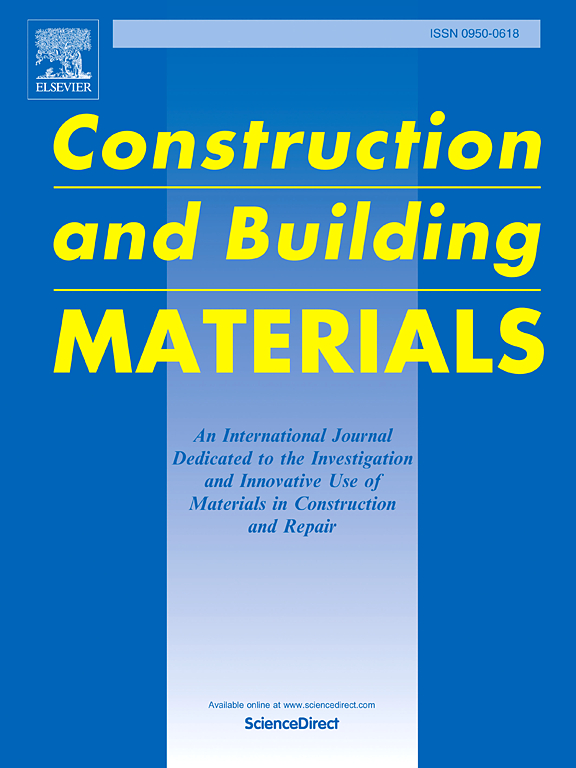Bonding behavior of GFRP bars and macro fiber reinforced concrete (MFRC): Tests and analytical modeling
IF 7.4
1区 工程技术
Q1 CONSTRUCTION & BUILDING TECHNOLOGY
引用次数: 0
Abstract
A novel environmentally friendly concrete has been recently developed in the authors’ group by incorporating macro fibers processed from waste glass fiber reinforced polymer (GFRP) composites into ordinary concrete. Owing to their superior anti-corrosion performance, the combined utilization of FRP composites and MFRC in structural construction is seen as a tremendous demand for coastal and marine construction as well as the potential for exploitation of marine resources. To ensure the compatibility between FRP bars and MFRC, superior bond performance is a prerequisite for the design and application of FRP reinforced MFRC structures. This paper has therefore conducted for studying the bond behaviors between GFRP/steel bars (specifically refers to GFRP bar or steel bar, rather than a hybrid of steel and GFRP bars) and MFRC through 72 pull-out tests with GFRP/steel bars embedded in macro fiber concrete. The effects of GFRP/steel bar diameters (8 mm, 12 mm, and 16 mm), bar embedded lengths (1d, 3d, and 5d), concrete strength (C30 and C50), and macro fiber contents (0.0 vol%, 0.5 vol%, 1.0 vol%, and 1.5 vol%) on the failure patterns, bond mechanism, and bond-slip curves of specimens were systematically analyzed. The test results indicate that the bond stress-slip curves of GFRP bars exhibit a sinusoidal decay after reaching the peak value, in contrast to the direct decline observed in conventional steel bars. With the increased rib height and decreased bar diameter, the bond strength between MFRC and FRP bars under pull-out conditions is enhanced accordingly. Increasing bonding lengths leads to a gradual decrease in the bond strengths, while the increase in concrete strengths and macro fiber contents generally improves the bond strengths. Within a reasonable range, the improvement of bond strengths will become more pronounced when the volume contents of macro fibers exceed 1.5 vol%. Overall, the influential parameters have a more significant impact on bond strengths between steel bars and macro fiber concrete compared to GFRP bars. Subsequently, this study also evaluates the accuracy and applicability of existing analytical models in predicting bond strengths between GFRP/steel bars and ordinary concrete, and then proposes corresponding modified prediction models for quantifying the bond-slip behavior between GFRP/steel bars and MFRC, resulting in more accurate predictions based on test results.
GFRP筋与宏观纤维增强混凝土(MFRC)的粘结性能:试验和分析模型
最近,作者小组将从废弃玻璃纤维增强聚合物(GFRP)复合材料中加工出来的宏纤维掺入普通混凝土中,开发了一种新型的环保混凝土。由于其优异的防腐性能,FRP复合材料和MFRC复合材料在结构建设中的应用被认为是沿海和海洋建设的巨大需求,也是海洋资源开发的潜力。为了保证FRP筋与MFRC之间的相容性,良好的粘结性能是FRP筋MFRC结构设计和应用的前提。因此,本文通过72次GFRP/钢筋嵌入宏观纤维混凝土的拉拔试验,研究了GFRP/钢筋(特指GFRP筋或钢筋,而不是钢与GFRP筋的混合)与MFRC的粘结行为。系统分析了GFRP/钢筋直径(8 mm、12 mm和16 mm)、钢筋埋设长度(1d、3d和5d)、混凝土强度(C30和C50)和宏观纤维含量(0.0 vol%、0.5 vol%、1.0 vol%和1.5 vol%)对试件破坏模式、粘结机制和粘结滑移曲线的影响。试验结果表明,GFRP筋的粘结应力-滑移曲线在达到峰值后呈正弦衰减,而常规钢筋的粘结应力-滑移曲线呈直接衰减。随着筋高的增加和筋径的减小,MFRC和FRP筋在拉拔条件下的粘结强度相应提高。随着粘接长度的增加,粘接强度逐渐降低,混凝土强度和宏观纤维含量的增加,粘接强度普遍提高。在合理范围内,当宏纤维体积含量超过1.5 vol%时,粘结强度的提高更为明显。总体而言,影响参数对钢筋与宏观纤维混凝土粘结强度的影响比对GFRP筋的影响更为显著。随后,本研究还对现有分析模型在预测GFRP/钢筋与普通混凝土粘结强度方面的准确性和适用性进行了评价,并提出了相应的修正预测模型,用于量化GFRP/钢筋与MFRC的粘结滑移行为,从而使基于试验结果的预测更加准确。
本文章由计算机程序翻译,如有差异,请以英文原文为准。
求助全文
约1分钟内获得全文
求助全文
来源期刊

Construction and Building Materials
工程技术-材料科学:综合
CiteScore
13.80
自引率
21.60%
发文量
3632
审稿时长
82 days
期刊介绍:
Construction and Building Materials offers an international platform for sharing innovative and original research and development in the realm of construction and building materials, along with their practical applications in new projects and repair practices. The journal publishes a diverse array of pioneering research and application papers, detailing laboratory investigations and, to a limited extent, numerical analyses or reports on full-scale projects. Multi-part papers are discouraged.
Additionally, Construction and Building Materials features comprehensive case studies and insightful review articles that contribute to new insights in the field. Our focus is on papers related to construction materials, excluding those on structural engineering, geotechnics, and unbound highway layers. Covered materials and technologies encompass cement, concrete reinforcement, bricks and mortars, additives, corrosion technology, ceramics, timber, steel, polymers, glass fibers, recycled materials, bamboo, rammed earth, non-conventional building materials, bituminous materials, and applications in railway materials.
 求助内容:
求助内容: 应助结果提醒方式:
应助结果提醒方式:


